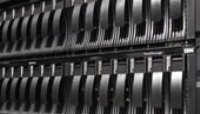Toshiba Demonstrates Hard Disk Breakthrough

Toshiba is to demonstrate a bit-patterned hard disk technology containing 2.5 Terabits of data per square inch
Toshiba on Wednesday is to demonstrate a disk drive prototype that contains 2.5 Terabits of data per square inch, or about four times the density of drives using the most advanced current technology.
The prototype, to be demonstrated at the Magnetic Recording Conference 2010 in San Diego, California, uses a technology called bit-patterned media (BPM), one of the major contenders for the next generation of rotating storage media.
Toshiba competitors Hitachi GST, Seagate and Western Digital recently formed the Storage Technology Alliance (STA) to coordinate an industry roadmap around such future technologies, and to determine whether to focus on BPM or approaches based on heat- or energy-assisted magnetic recording. Toshiba hasn’t yet decided whether it will join the STA.
Industry first
Bit-patterning stores data in patterns of dots, with each dot representing a single bit (a 1 or a 0) of memory. Toshiba said its prototype uses 17-nanometre dots manufactured using an etching mask made of a self-assembled polymer.
The company said its prototype represents the first time a drive maker has been able to control a read/write head flying over a BPM with self-assembled dots and stopping on a particular data track. The company said this is also the first time a manufacturer has been able to fabricate a BPM with an orderly servo pattern made of dot arrays.
The company hasn’t yet demonstrated the ability to read and write data using its approach.
 “This is the first time anyone has demonstrated the servo-control operation of a recording head flying on a bit patterned media with self assembled dots,” Hitachi said in a statement. “Further development of this technology will achieve fundamental HDD operation; writing and reading data to and from individual dots.”
“This is the first time anyone has demonstrated the servo-control operation of a recording head flying on a bit patterned media with self assembled dots,” Hitachi said in a statement. “Further development of this technology will achieve fundamental HDD operation; writing and reading data to and from individual dots.”
Roadmap questions
The work was funded in part by Japan’s New Energy and Industrial Technology Development Organisation. Toshiba said it also worked with Japan’s Storage Research Consortium on the development of the project.
Some major storage manufacturers, such as Seagate and Western Digital, have in the past expressed more interest in heat-assisted magnetic recording (HAMR) than in BPM, but the situation is continuing to develop. For instance, Seagate is also presenting papers on BPM at this week’s Magnetic Recording Conference 2010.